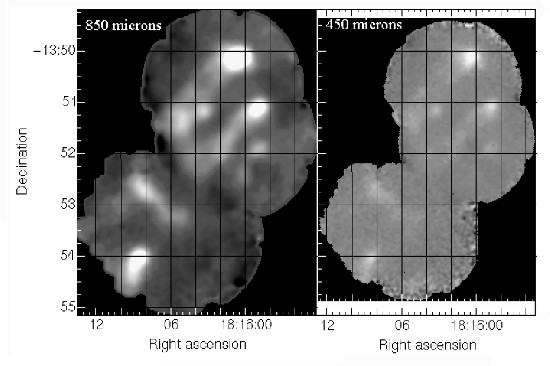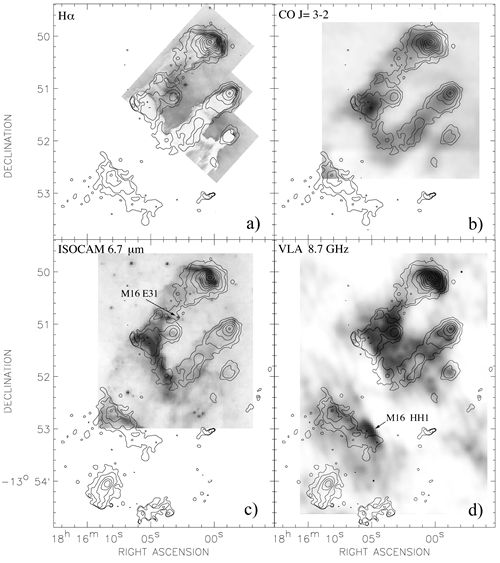|
||||
|
The Eagle Nebula M16, The Eagle Nebula, is a prominent HII region lying 2 ± 0.1 kpc from the Earth. Optical images show it to be crossed by several opaque 'Elephant Trunks', which appear as 'fingers', or columns of dense obscuring material projected against the diffuse background nebular emission, The picture below shows our recent SCUBA images of the submillimetre wave radiation. Details and more images can be found in the paper White et al. Astronomy &. Astrophysics 342, 233, 1999.
The star cluster NGC6611 is associated with the Eagle Nebula, and contains the largest population of intermediate-mass pre-main-sequence stars known in any young cluster in the Galaxy (Hillenbrand et al 1993). It is made up of several hundred optically visible stars whose masses lie in the range 3 < M < 8 solar masses, and ages range from ~ 0.25 to 3 million years. While most of the stars in this cluster seem to have formed in a mini-starburst ~ 2 million years ago, high-mass star-formation has continued over a period of at least 6 million years (Hillenbrand et al 1993). A recent study with the Hubble Space Telescope (HST - Hester et al 1996) revealed a population of optical globules, at least some of which may be associated with circumstellar discs around stars which are in the final stages of pre-main sequence development (McCaughrean 1997). The radiation from nearby O-stars has photo-evaporated much of the material in the original molecular cloud, and the fingers may mark the location of dense clumps which existed in a primordial molecular cloud. These dense clumps would then have shielded the material behind from the effects of the UV radiation, leading to the formation of the fingers (similar to the way that 'capstones' can effect the geological erosion of material on the earth). Some images taken from our recent paper at millimetre and submillimeter wavelengths is shown here, with the 450 micron continuum image (contours) superimposed on other tracers..
The surface layers of these fingers are ionised by the UV radiation emitted by several O5 stars lying about 2 pc to the NW, which provide a total flux over the fingers of ~ 2 10^50 photons s-1 (Hester et al 1996). The material inside the surface layers must therefore be subjected to the pressure of the surrounding hot gas, although the state of dynamical equilibrium will also depend on the internal pressure and the gravitational stability of the cores. The optical appearance of the fingers suggests that dense, opaque material near the tips of the fingers may have shielded the material lying behind it from the effects of the radiation, and that this shielding may have contributed to the formation of the finger structures. We have developed a model which starts from a mesh of points in 3D which represnts the material at the tips of the fingers. The chemical model used here is the same as that used by Nelson and Langer (1998) in dynamical collapse calculations for isolated molecular clouds. This model is designed to capture the essentials of the carbon and oxygen chemistry, since these species and their molecules are responsible for the majority of the cooling that occurs in the cloud. In the model, the following species are evolved: CO, CI, CII, HCO+, OI, He+, H3+, OHx, CHx, M+ and e. Here the OHx species represents H2O, OH and O2, and the CHx species represents CH2 and CH. These species are grouped together for the sake of simplicity, and because their reactions occur at similar rates and along similar pathways. The M+ species represents ionised Fe, Na, Mg and Ca, which provide a background source of electrons in highly shielded regions.
Conclusions
The cores we have discovered in the tips of the Eagle Nebula's fingers appear to be similar to those of the earliest stages of protostellar activity |
|
|




